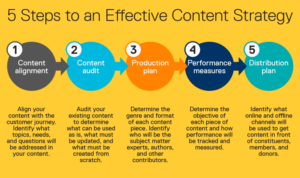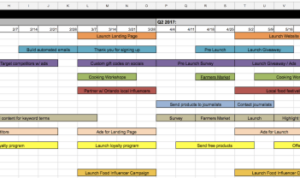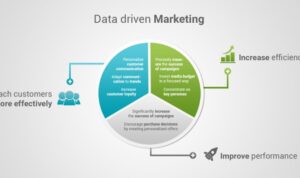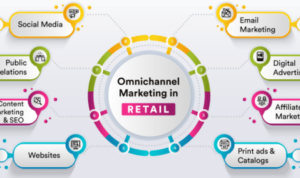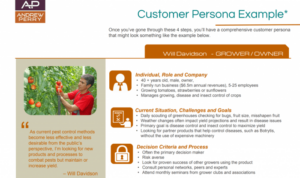Developing a Content Marketing Funnel dives into the essential components of attracting, engaging, and converting customers through strategic content. From creating awareness to driving conversions, this guide will equip you with the knowledge needed to elevate your marketing game.
Introduction to Content Marketing Funnel: Developing A Content Marketing Funnel
When it comes to hustling in the digital game, having a solid content marketing funnel is like having the ultimate playbook. A content marketing funnel is basically a strategic way of guiding your audience through the different stages of their journey – from the initial awareness of your brand to making that sweet, sweet purchase. It’s all about delivering the right content at the right time to keep your peeps engaged and coming back for more.
Now, why is developing a content marketing funnel so crucial for businesses? Well, let me break it down for you. Having a well-crafted funnel helps you build relationships with your audience, establish credibility, and ultimately drive those conversions. It’s like setting up a dope party where everyone’s vibing with your brand and ready to throw down some cash.
Need some inspo? Look no further than the masters themselves. Take a peek at how Netflix hooks you in with those binge-worthy trailers, or how Airbnb lures you in with dreamy travel guides. They know how to work that funnel like a boss, keeping you hooked from start to finish.
Examples of Successful Content Marketing Funnels
- Netflix: They reel you in with personalized recommendations, engaging trailers, and killer content that keeps you glued to the screen.
- Airbnb: From inspiring travel guides to user-generated content, Airbnb knows how to create a sense of wanderlust that leads to booking that dream vacay.
- HubSpot: With their informative blog posts, free tools, and expert guides, HubSpot has mastered the art of nurturing leads and turning them into loyal customers.
Stages of a Content Marketing Funnel
When it comes to content marketing funnels, there are typically four main stages that businesses focus on to guide their audience through the buyer’s journey. Each stage serves a specific purpose and has unique goals to help move potential customers closer to making a purchase.
Awareness Stage
In the awareness stage, the main goal is to grab the attention of your target audience and make them aware of your brand, product, or service. This is usually done through creating valuable and engaging content that addresses the pain points or needs of your audience. Businesses often use blog posts, social media content, videos, and infographics to attract and educate their audience in this stage.
Interest Stage
Once potential customers are aware of your brand, they move into the interest stage. The goal here is to nurture the relationship with your audience and provide them with more in-depth information about your offerings. Businesses often use email marketing, webinars, case studies, and whitepapers to engage with their audience and showcase the value of their products or services.
Decision Stage
In the decision stage, potential customers are ready to make a purchase decision. The goal here is to convince them that your product or service is the best solution for their needs. Businesses often use product demos, free trials, testimonials, and comparison guides to help prospects make an informed decision and convert them into paying customers.
Action Stage
The final stage of the content marketing funnel is the action stage. This is where potential customers take the desired action, whether it’s making a purchase, signing up for a subscription, or requesting a quote. The goal here is to make the conversion process as seamless as possible and provide support to customers to ensure a smooth transition into becoming loyal advocates for your brand.
Creating Awareness
When it comes to the top of the content marketing funnel, the main goal is to attract a broad audience and create awareness about your brand, product, or service. This stage is all about capturing the attention of potential customers and introducing them to what you have to offer.
Strategies for Creating Awareness
- Utilize social media platforms to promote your content and reach a larger audience.
- Invest in search engine optimization () to improve your website’s visibility in search engine results.
- Create engaging and shareable content such as blog posts, videos, infographics, and podcasts.
- Collaborate with influencers or industry experts to expand your reach and credibility.
Examples of Effective Top-of-the-Funnel Content
- A viral video showcasing the benefits of your product in a creative and entertaining way.
- An informative blog post addressing common pain points of your target audience.
- A social media campaign with interactive quizzes or contests to engage users and generate buzz.
- An email newsletter sharing valuable industry insights and exclusive offers to subscribers.
Attracting a Broad Audience
- Use eye-catching visuals and compelling headlines to capture attention on social media feeds.
- Target relevant s in your content to attract organic traffic from search engines.
- Promote your content across multiple channels to reach a diverse audience.
- Offer valuable resources or freebies in exchange for email sign-ups to grow your subscriber list.
Generating Interest
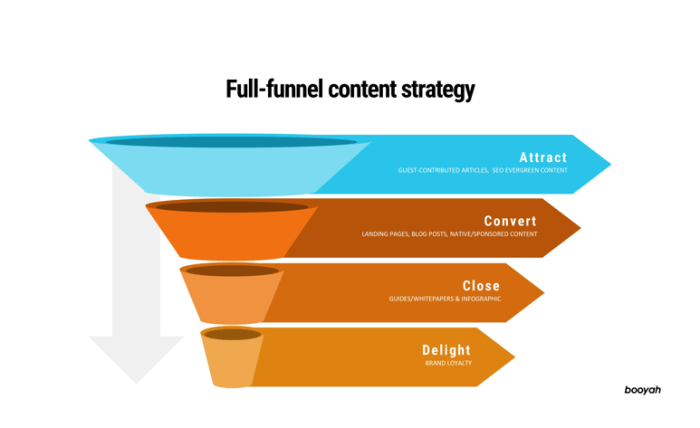
In the middle of the content marketing funnel, it’s crucial to focus on generating interest to keep potential customers engaged and moving towards making a purchase. This stage is all about capturing the attention of your audience and nurturing their interest in your product or service. Here are some tactics for generating interest in the middle of the funnel:
Types of Content
- Case Studies: Showcasing real-life examples of how your product or service has helped customers can be incredibly compelling and help potential customers see the value you offer.
- Webinars: Hosting webinars that provide valuable information related to your industry can help position your brand as an authority and keep audiences engaged.
- Product Demos: Offering product demos can give potential customers a firsthand look at how your product works and how it can benefit them.
Examples of Successful Campaigns, Developing a Content Marketing Funnel
-
Red Bull’s Stratos
: Red Bull’s Stratos campaign, which featured skydiver Felix Baumgartner jumping from the edge of space, generated massive interest and engagement, showcasing the brand’s adventurous spirit.
-
Dollar Shave Club’s Viral Video
: Dollar Shave Club’s viral video, showcasing their affordable and convenient shaving products, captured the attention of audiences and helped drive interest in their subscription service.
-
Tesla’s Product Unveils
: Tesla’s product unveil events, where they showcase their latest innovations in electric vehicles, generate massive interest and anticipation among their audience, driving engagement and interest in their offerings.
Driving Conversions
When it comes to converting leads into customers at the bottom of the content marketing funnel, it’s crucial to have a solid strategy in place. This stage is all about pushing those potential customers over the finish line and turning them into paying clients.
Role of Calls-to-Action (CTAs)
- CTAs play a vital role in driving conversions as they guide the audience on what action to take next. Whether it’s signing up for a free trial, downloading a resource, or making a purchase, CTAs provide a clear path for leads to follow.
- Make sure your CTAs are compelling, visually appealing, and strategically placed throughout your content to capture the audience’s attention.
- Use action-oriented language in your CTAs to prompt immediate responses from your leads. Phrases like “Get Started Now” or “Claim Your Discount Today” can create a sense of urgency and encourage conversions.
Optimizing Content for Conversion
- Focus on creating content that addresses the pain points of your target audience and highlights how your product or service can solve their problems. Tailor your messaging to resonate with their needs and motivations.
- Include customer testimonials, case studies, and reviews in your content to build credibility and trust with potential customers. Social proof can significantly influence purchase decisions at this stage.
- A/B test different variations of your landing pages, forms, and CTAs to identify what resonates best with your audience. Analyze the data to optimize your content for higher conversion rates.
Retaining Customers

In order to keep customers coming back for more, it’s crucial to focus on post-purchase content that nurtures relationships and builds loyalty. By providing valuable information, support, and personalized experiences after the initial purchase, you can increase customer retention rates and create brand advocates.
Importance of Post-Purchase Content
Post-purchase content plays a vital role in retaining customers by ensuring they have a positive experience with your brand beyond the point of sale. By continuing to engage with customers after they’ve made a purchase, you can strengthen their connection to your brand, encourage repeat purchases, and foster long-term loyalty.
Examples of Post-Purchase Content
- Personalized thank-you emails with exclusive offers for future purchases
- Product usage guides, tips, and tutorials to help customers make the most of their purchase
- Customer feedback surveys to gather insights and show you value their opinions
- Loyalty programs that reward customers for their continued support
Nurturing Customer Relationships
Building relationships with customers goes beyond the initial purchase. To nurture these relationships effectively, focus on providing ongoing value, personalized communication, and exceptional customer service. By staying in touch, addressing customer needs, and showing appreciation for their loyalty, you can create a strong bond that keeps customers coming back for more.







